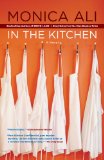
Critics' Opinion:
Readers' Opinion:
First Published:
Jun 2009, 448 pages
Paperback:
May 2010, 448 pages
 Book Reviewed by:
Book Reviewed by:
Judy Krueger
Buy This Book
In the Kitchen is essentially a descent-into-madness tale, and we're warned of this in the novel's very first paragraph:
When he looked back, he felt that the death of the Ukrainian was the point at which things began to fall apart… it was the following day on which, if a life can be said to have a turning point, his own began to spin.
As the story unfolds, Gabriel Lightfoot's incipient breakdown reveals its roots: his mother's manic/depressive state, his mill town upbringing, his own desperate plans to make something of himself in the world of high class London restaurants, and the changing patterns of British society due to immigration and economics.
Though written in the third person, the point of view is all Gabriel's, who has contentious relationships with everyone in his life. He suffers from a debilitating inability to communicate, and is sorely out of touch with his kitchen crew, particularly with women. To top it off, he's self-absorbed, makes bad decisions, and acts inappropriately -
but his position as an Executive Chef excuses him; people expect him to be high-strung.
I can't say that Monica Ali has given us the easy read she created in Brick Lane. To spend over four hundred pages inside the mind of an unlikable man who is going down is unpleasant in the extreme, and there's not one other admirable character in this entire novel.
What is admirable is Monica Ali's writing. Some reviewers have complained of over-writing, awkward dialogue, and an imbalance between issues and story. On the contrary, Ali illuminates the detachment of modern day life through her characters, as well as the damage done by immigration policies and human trafficking. Every bit of dialogue demonstrates the missed human connections of her troubled characters, and the kitchen works as a perfect metaphor for the simmering tensions of life in twenty-first century London.
Being under so much stress, Gabriel has nightmares about the dead man found in the kitchen's catacombs, until he's barely able to sleep at all. As he begins his final descent, the writing becomes as surreal and insane as Gabriel's state of mind and speeds the reader through several days of pure madness. Watching him pretty much destroy everything he has been working towards while he inadvertently solves the mystery at the heart of the story feels like a fever breaking.
In the Kitchen is not the book for someone looking for a heartwarming or comforting read. It is disturbing, irritating, even maddening at times, but is it also brilliantly done.
![]() This review was originally published in July 2009, and has been updated for the
May 2010 paperback release.
Click here to go to this issue.
This review was originally published in July 2009, and has been updated for the
May 2010 paperback release.
Click here to go to this issue.
PERSONNEL
Chef: the cook in charge of a restaurant; from the French chef de cuisine, literally the head of the kitchen.
Executive Chef: sometimes called the head cook, he or she is the one responsible for running the food preparation in a kitchen, ordering food and supplies, making staff schedules, dealing with administrative tasks. Executive chefs are usually employed by large restaurants, hotels, country clubs and even cruise lines. Most manage a staff of at least ten employees.
Sous Chef: a chef’s assistant, from the French sous meaning "under."
Chefs de Partie: each runs one section of the kitchen, oversees prep, cooking, and presentation of meals, and directs the chefs under him in that section.
Commis Chef: a trainee chef who has the most junior position in the kitchen. Commis is French for "clerk."
IN THE KITCHEN
Mise-en-place: French culinary term meaning "put in place." It means a set up with all the ingredients and components ready to prepare a dish, from chopped veggies to cooking tools.
The Pass: the place where the finished dishes are passed over from the chefs to the waiting staff and which acts as the final quality control area before any food leaves the kitchen.
Salamander: part of a grill cook’s area; a small broiler oven used to quickly brown, glaze, cook, broil, or toast various foods. The Salamander is often used to provide the nicely browned crust to a crème brûlée, an au gratin dish, or toasted bread.
FOOD TERMS
Vol-au-vents: meaning "windblown," to describe the lightness of this puff pastry shell with savory filling.
En papillote: From the French papillon which means butterfly, this describes a cooking method in which the ingredients are sealed in a parchment paper or foil pouch and baked in the oven to steam in its own juices. Usually used to cook seafood.
RATINGS
Michelin Stars: Ratings from the famous guide for restaurants, prepared from the reports of anonymous inspectors. 1 star indicates "a very good restaurant in its category," 2 stars "excellent cooking, worth a detour," and, the holy grail for serious chefs, 3 stars: "exceptional cuisine, worth a special journey." In 2008, a mere 68 restaurants in the entire world received a 3-star rating.
![]() This review was originally published in July 2009, and has been updated for the
May 2010 paperback release.
Click here to go to this issue.
This review was originally published in July 2009, and has been updated for the
May 2010 paperback release.
Click here to go to this issue.
Your guide toexceptional books
BookBrowse seeks out and recommends the best in contemporary fiction and nonfiction—books that not only engage and entertain but also deepen our understanding of ourselves and the world around us.